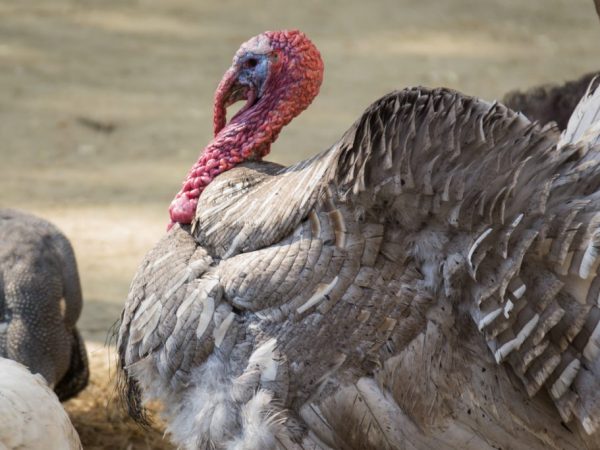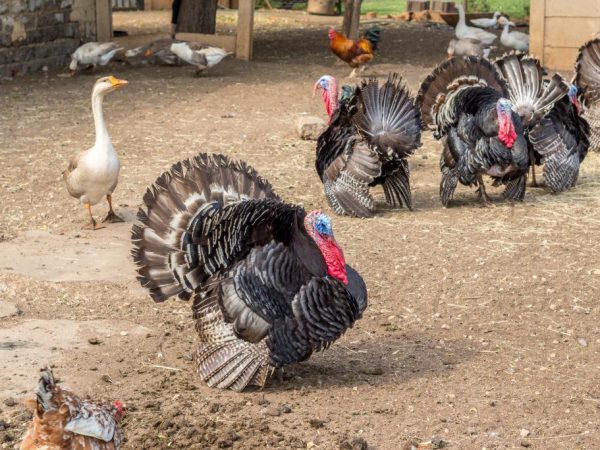Description of turkeys of the Blue Aspid breed
blue turkeys are a very interesting and peculiar breed. They are often also called Aspid. The bird was bred not so long ago and was most often used as a decorative one. Blue turkeys are rarely found on farms. After all, this is not a very common breed.

Turkeys of the breed Blue Aspid
Turkeys are sometimes called blue because they have a blue tint to their feathers. Those who first see such a breed cannot believe their eyes that they are of this color.
Characteristics of the Aspid breed
A description of the breed can be found on the Internet very rarely. After all, this bird most often lives in zoos. Breeders are not interested in blue turkeys, because they are small in weight. An adult male reaches 5 kg, and the weight of a female is one and a half kilo less. Therefore, it makes no sense to keep them to get meat.
Slate turkeys have pink toes and feet. Their beak is gray in color, and their eyes are dark brown. The turkey has a light-colored feathers with a blue tint. They are often used to participate in exhibitions, because they are birds of unusual beauty.
How to care for Blue Turkeys
Aspid turkeys, like other breeds, tolerate cold easily, but they like warmer rooms and climates. In the poultry pen should be warm and dry, moisture should not be allowed. There must be a litter on the floor, which must be changed regularly.
It is also worth keeping a close eye on newly born birds. Turkey poults in the first days of life should be kept in a dry and warm room. Often a box made of cardboard is used for this. The turkey poults should be in a box where the temperature is 36 degrees. When the kids grow up a little, they can be transferred to adult turkeys.
The room in which the slate turkeys will live must be equipped in accordance with all the rules. One square meter of the dwelling is designed for two birds. Therefore, it is worth considering in advance how many birds you will have. Also, the temperature in the room must comply with the norm. In the cold season, it should not be less than 5 degrees, and in the warm season - 20 degrees.
In order for the turkey to develop properly in the barn, lighting is imperative. This can be done with a conventional 60 watt light bulb. In order to prevent moisture from collecting in the room, it must be equipped with ventilation. It is also necessary to make perches where birds of this breed will rest and lay eggs.
The food of the Aspidbirds
To get good birds of this breed need to feed properly them, blue turkey chicks require a special diet. Most often, people who breed slate breeds acquire special food. But if you want, you can use different grains, herbs and some vegetables. During the warmer months, the turkey needs to be walked. With the help of walking, the breed can feed itself.
If turkey and turkey poults eat artificial feed, then they must definitely introduce vitamin supplements into the diet.It is also advisable to give grated carrots, beets and cabbage. Bluebirds are very fond of oats, grains and barley. Therefore, you can not worry, it will not be difficult to pick up food for your pet.
Turkey poults should be eaten 8 times a day. This allows them to improve their health and accelerate growth. The first three days after birth, they should be fed with dry flour grits and mixed with boiled chopped eggs. Poults should receive this feed until they are one month old. After they reach this age, babies can be safely transferred to adult nutrition.
Nutrition during puberty also plays a very important role in slate turkeys. In birds of this breed, it occurs at the age of 8-10 months. Therefore, during this period, you should carefully monitor what the pet eats. At puberty, the turkey should eat five times a day.
In winter, the nutrition of slate birds should be the same as not during puberty. But in the summer it is necessary to mix the food together with vegetables and yeast. With such a diet, turkeys will survive this period faster and will be able to bring healthy offspring into this world.
Breeding of feathered Aspid breeds

Beautiful poultry
In the description above, it has already been indicated that a turkey of this breed is rarely used for breeding, despite its attractive appearance. But there are some farmers who breed birds of this breed. If you wish, you can take a small chicken and grow a full-fledged turkey from it. To get a full-fledged egg, you need to have eight females and one male. Only in this case will the female be able to lay the fertilized egg.
If the turkey has laid its own eggs and decided to incubate them, then this process will last about a month. It is desirable that this period falls in the spring. There must be at least 17 eggs under one bird. If the female is hatching turkey poults for the first time, then you should not lay a large number of eggs under her. The expectant mother should be placed separately from the rest of the birds and should be kept until the chicks grow up a little.
The blue female is the best mother among birds. She takes a responsible attitude not only to hatching the offspring, but also to their upbringing. But there are also situations when the turkey does not want to hatch eggs. In such cases, the farmer uses incubators.
In order to get offspring without the help of a bird, eggs need to be placed in an incubator... They should be placed with the sharp end down. A farmer can get turkey poults in 28 days. For the first twenty days, the eggs must be constantly turned over and the temperature regime must be observed. The number of coups should be 12 times a day.
Diseases of Asp Turkeys
Most often, birds of this breed are sick when they are bred at home. This is due to the fact that the breed is in contact with other animals. If such a domestic turkey came into contact with a sick pet, then he will pick up the same ailment one hundred percent.
In slate turkeys, like other animals, diseases are divided into: infectious and viral... Many of them can be avoided, but for this, first of all, you need to make sure that they do not come into contact with other pets. Proper care and nutrition is also very important.
The most common diseases of asps:
- If the breed has a runny nose, then this indicates that it is ill with respiratory mycoplasmosis. This ailment appears when the humidity in the room does not correspond to the norm.
- The most dangerous and widespread disease not only among animals, but also among people, is tuberculosis. It affects the respiratory tract. This ailment is transmitted through dirty food and water.
- If the breed behaves sluggishly and eats it poorly, it speaks of a disease such as histomonosis... A turkey will become infected, it can only be if the room where it was settled was not pre-processed.
- Also, a turkey, like any other animal, may have worms.This disease is the most common and affects not only the digestive system, but also the respiratory organs. The breed can become infected through any food.
- The most smallpox is a dangerous disease... If the feathered one is sick with it, then it is impossible to cure it. Therefore, he is killed and burned. This is to prevent others from getting sick.
So that your pet does not get sick, you need to carefully monitor him. While cleaning the barn, change the litter. It is imperative to establish a ventilation system. After all, high humidity is the first step towards the occurrence of various diseases.
Be sure to keep an eye on the foods that you introduce into the diet of a slate turkey. If your pet eats ready-made food, then buy only those in which you are confident. Only by following these simple rules can infection be avoided.
Conclusion
The blue turkey is a very interesting and beautiful bird, but not everyone is ready to keep it.
After all, she eats the same way as a turkey of any other breed, and gives very little meat. Therefore, if you decide to breed such birds, then you should first think carefully about whether you are ready to grow such a breed.
Abroad, slate breeds are very popular. After all, such a bird can safely replace an ordinary parrot. She has a pliable personality and is very playful.


